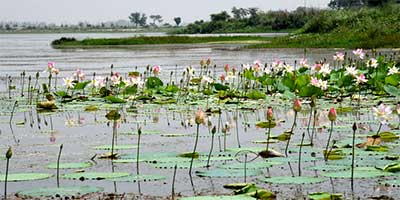Date : 28/08/2023
Relevance: GS Paper 3- Environment- Flood Plain Restoration
Keywords: Model Bill on Floodplain Zoning 1975, NDMA, Wetland, Biodiversity Park,
Context-
- In the wake of the recent floods, the Yamuna Biodiversity Park and other restoration projects along the Yamuna's floodplains have displayed varying responses to the inundation.
- This divergence prompts an exploration of effective restoration approaches.
Differential Responses to Flooding
- Located around 500 meters from the Yamuna at Jagatpur, the 457-acre Yamuna Biodiversity Park stood largely unscathed amidst the flooding. The park's floodplain area was nearly unrecognizable as the water receded, leaving no significant damage.
- The Asita East area, near the ITO Bridge, struggled with water accumulation, which experts attribute to blocked water drainage paths.
- Similarly, the floodplain project area near the Commonwealth Games Village remained submerged, necessitating manual removal of silt from the deposited areas. Qudsia Ghat, near Kashmere Gate ISBT, faced the deposit of substantial silt, demanding laborious removal efforts. These disparities in outcomes beg the question: why did these projects respond differently to the floods?
- The Yamuna Biodiversity Park's Success Story: The Yamuna Biodiversity Park's restoration efforts encompass a 100-acre wetland, rejuvenated from an abandoned channel of the Yamuna. The wetland, a natural reservoir, effectively absorbs excess water during floods and aids in gradual water release. The park's grasslands, a mix of four grass varieties, demonstrate resilience as they revive post-flooding due to their robust root systems.
Importance of Floodplains
- Preventing Flood: The riparian zone near the river, comprising wetlands, grasslands, and floodplain forests, plays a vital role. Grasslands act as sponges, retaining water and preventing erosion. Wetlands facilitate water drainage into the river, subsequently replenishing the floodplain. This intricate interplay contributes to flood mitigation, water quality improvement, and overall ecosystem health.
- Ecological Function: The floodplains play a crucial role in recharging groundwater and retaining excessive water. They serve as a protective barrier during flood events, decelerating the flow of water. The sediments found in floodplains contribute to the formation of aquifers that replenish groundwater.
- Sustaining Livelihoods: A report from 2022 identified 56 settlements accommodating 46,750 residents along these floodplains. Approximately half of these households are engaged in agriculture, while others rely on daily labor, fishing, and animal herding for their livelihoods.
- Significance in Agriculture: The fertile sediment deposited by the river enriches the soil and supports agricultural activities. Traditional crops such as rice, wheat, and flowers thrive in these areas.
- Addressing Housing Shortages: Historically, many displaced or migrating individuals have sought shelter in these areas due to their affordability.
The Yamuna River's floodplains confront several challenges
- Urban Encroachment: The floodplains are affected by rapid urbanization and poorly planned construction activities. Instances include the Akshardham Temple, Commonwealth Games Village, and upscale residential complexes.
- Loss of Floodplain Area: This phenomenon limits the natural flow of the river, escalating the potential for flooding. Notably, Delhi witnessed significant floods in 1978, 1988, and 1995.
- Inadequate Policy Framework: The Master Plan lacks comprehensive floodplain zoning provisions, contributing to the challenges faced by these areas.
- Climate Change Impact: The increasing intensity of rainfall results in swift river swelling, exacerbating flood risks.
- River Constriction: Construction projects that encroach upon the river's space restrict its capacity to expand and accommodate water flow, impeding its natural processes.
- Pollution Concerns: The escalating population has outpaced the development of sewage infrastructure, causing heightened pollution of the river.
What should be done?
- Preserve Floodplains: Stop encroachments to maintain the river’s natural flow. Examples: Stop projects like the Commonwealth Games Village on floodplains.
- Policy Improvements: Include floodplain zoning in the Master Plan. Only four states have a National Floodplains Zoning Policy.
Model Bill for Flood Plain Zoning-
- The objective of floodplain zoning regulations is to prohibit or limit developmental activities within floodplain areas. This is done to mitigate the potential loss of life and property and to minimize the adverse effects of flooding.
- The Central Water Commission formulated guidelines for floodplain zoning, and the Government of India shared the Model Bill for Floodplain Zoning in 1975.
- Subsequently, four states translated this into action by enacting floodplain zoning laws: Manipur in 1978, Rajasthan in 1990, Jammu and Kashmir in 2005, and Uttarakhand in 2012.
The National Disaster Management Authority (NDMA) in 2008 issued guidelines for states for floodplain zoning as an important “non-structural measure” to mitigate floods.
- Climate-Resilient Infrastructure: Create infrastructure that can withstand heavy rains.
- River Health: Focus on de-silting drains and rejuvenating the river.
- Enhance Drainage Systems: Improve city drainage to prevent flooding.
- Green Areas: Develop more green spaces for natural water absorption.
- Objective Standards: The incorporation of objective benchmarks, such as the 'Basic Structure Doctrine,' can enhance the consistency and effectiveness of restoration projects.
- Community Engagement: Encouraging active citizen participation fosters a sense of responsibility and ownership, ensuring the sustainability of restoration efforts.
- Institutional Oversight: Establishing strong and independent institutions, like the judiciary and relevant regulatory bodies, aids in upholding the principles of restoration and floodplain management.
Conclusion
The floods' aftermath showcases the diverse responses of restoration projects along the Yamuna's floodplains. While the Yamuna Biodiversity Park demonstrates the resilience of well-planned floodplain restoration, other projects faced challenges that demand strategic adjustments. By drawing from these experiences, India can refine its floodplain restoration endeavors, harnessing the potential of these natural ecosystems to mitigate floods, enhance water quality, and preserve biodiversity. Effective restoration, informed by the lessons of both success and adversity, can ensure a harmonious coexistence between the river and the surrounding environment.
Probable Questions for the UPSC Mains Exam
- What is the role of wetlands and grasslands in floodplain areas in terms of flood mitigation and overall ecosystem health? (10 Marks,150 Words)
- How does the Yamuna Biodiversity Park serve as a successful model for floodplain restoration, and what factors contribute to its resilience during flooding events? (15 Marks,250 Words)
Source - The Indian Express








